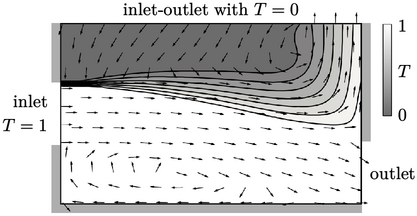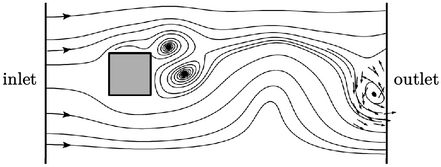4.10 Mixed inlet-outlet condition
The inlet-outlet boundary condition is the
most basic example of the mixed fixed value/gradient type, described
in Sec. 4.9
. The condition sets the reference
gradient  and uses a specified reference value
and uses a specified reference value  . The value fraction is
then set to
. The value fraction is
then set to
 |
(4.11) |
 at each boundary face, described in Sec. 2.8
, by
at each boundary face, described in Sec. 2.8
, by
 |
(4.12) |
 ,
etc. It has an immediate
practical use at a free boundary, e.g. in the case introduced in
Sec. 4.6
.
,
etc. It has an immediate
practical use at a free boundary, e.g. in the case introduced in
Sec. 4.6
.

The figure shows the solution of
Eq. (2.65
),
converged over time with  and unity Prandtl number
and unity Prandtl number  , see
Sec. 2.21
. The fixed condition
, see
Sec. 2.21
. The fixed condition
 is
applied at the inlet and a zero gradient condition
is
applied at the inlet and a zero gradient condition  at the walls.
at the walls.
At the free boundary, the inlet-outlet condition
enables  to be specified where inflow occurs. The inlet value in the
example is set to
to be specified where inflow occurs. The inlet value in the
example is set to  ; the image shows mixing of fluids at different
temperatures, from the inlet and entrained at the free boundary.
; the image shows mixing of fluids at different
temperatures, from the inlet and entrained at the free boundary.
Numerical benefit of inlet-outlet
Boundaries may be described “inlet” and “outlet” based on the expectation of the flow direction during a simulation. But the flow direction may not always happen as expected.
In the case of an outlet, for example, inflow might occur during a simulation. For example, at the start of a simulation, the initial conditions may induce inflow before the internal flow is established. Localised inflow can also occur when rotating flow structures pass through an outlet boundary, e.g. when a bluff body sheds vortices, as shown below.

Where inflow occurs, the inlet-outlet condition
can switch to the fixed value type to ensure stability, as discussed
in Sec. 4.5
. The inlet-outlet
condition is therefore commonly applied to scalar fields (except
 ),
at a boundary which is notionally an outlet, to avoid numerical
instability associated with unexpected inflow.
),
at a boundary which is notionally an outlet, to avoid numerical
instability associated with unexpected inflow.

